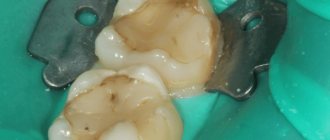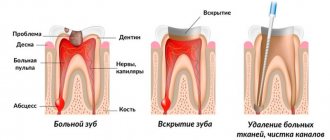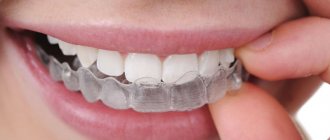Prosthetics with crowns
Installing a crown on a tooth is a procedure to restore its anatomical shape, color, chewing function and aesthetics.
In practice, any tooth under a crown (with or without a preserved nerve) can begin to hurt. In this case, only a specialist can provide assistance. Lack of professional treatment or late contact with a doctor aggravates the situation; removal of the causative tooth may be necessary.
After professionally performed prosthetics, pain should not occur. At first, you may experience some discomfort associated with getting used to the new product in your mouth. If you have a crown installed and your tooth hurts, you should immediately tell your doctor about it.
When is pain normal?
Even a perfectly installed crown can provoke painful sensations immediately after prosthetics - as the local anesthesia wears off. The pain may be constant or occur with pressure. How to distinguish these sensations from those caused by pathology?
Firstly, pain normally lasts no more than 1-3 days - this is due to the adaptation of tissues to the new structure in the oral cavity.
Secondly, the pain tends to subside. Increasing sensations indicate a pathological process.
Causes of pain
There are quite a few reasons why a tooth hurts under the crown, these include:
- Pulpitis is inflammation of the neurovascular bundle inside the tooth. The main cause of the pathology is infection in the root canal system, injury to the pulp. The disease can also occur when teeth are covered with a crown without removing the nerve. Pulpitis manifests itself as acute spontaneous pain, which over time may subside or become aching.
- Periodontitis is an inflammation of the periodontal tissues that surround the root of the tooth. The disease manifests itself when infection enters the periodontal space from the root canals. A common cause of pathology is poor-quality treatment or filling of canals. With periodontitis, the tooth hurts under the crown when pressing, eating, or applying pressure.
- Periostitis is an inflammation of the periosteum - the periosteum that surrounds the jaw bone. The disease occurs due to the spread of infection from surrounding tissues, often from poorly treated root canals. If the tooth under the crown hurts, the gums are swollen, or facial asymmetry appears, this indicates periostitis.
- Periodontitis is an inflammation of the gums, the circular ligament of the tooth and the tissues that surround and hold the tooth in the jaw. The disease can occur in the presence of somatic diseases of the body or an incorrectly installed tooth crown. Symptoms of periodontitis include bleeding gums, tooth mobility, pain, and bone destruction.
- Exacerbation of a chronic disease - cysts, granulomas . Decreased immunity can cause exacerbation of chronic inflammatory processes in teeth that are covered with crowns. Patients report acute pain in the tooth, swelling and redness of the gums.
- Sinusitis is inflammation of the mucous membrane of the maxillary sinus (maxillary sinus). The disease occurs due to infection in the sinus, disruption of the outflow of exudate, as well as from poorly treated maxillary molars (odontogenic sinusitis).
Other reasons why a “dead” tooth under a crown hurts include poor-quality canal treatment, the presence of nerve residues in the tooth, breakage of instruments in the canal, and the presence of inflammatory processes in periodontal tissues.
A pulpless tooth hurts
If the pulp has been removed, the pain is most often aching. It can radiate to the temple or ear. The main reason for this phenomenon is the exacerbation of chronic periodontitis. The choice of therapy method is determined by the presence or absence of a pin in the tooth root canal:
- there is no pin: the doctor opens the crown, unseals the root canals and treats them properly, after which he places materials impregnated with antibacterial agents into the tooth. Several changes to the medication may be required until complete relief is obtained and the inflammatory process is eliminated. After the symptoms have completely subsided, the canals are filled again and a new crown is installed;
- there is a pin: the doctor can cure periodontitis through surgery - resection of the apex of the tooth root. It is performed through a small incision in the gum, through which the source of infection is removed, and if necessary, the resulting void is filled with osteoplastic material. Typically, the intervention lasts from 30 to 60 minutes and is well tolerated by patients.
What to do at home?
If a tooth with a crown hurts, then you need to quickly visit a specialist - a dentist. Before visiting a doctor, you can take the following measures:
- Take a pain reliever. It is better to use medications from the group of non-steroidal anti-inflammatory drugs - Paracetamol, Nimesil, Ibuprofen, Tempalgin, Ketanov;
- Carefully carry out hygienic cleaning of teeth and interdental spaces;
- Rinse the mouth with decoctions of medicinal herbs;
- Rinse with a salt-soda solution every 1-2 hours. To prepare the solution, you need to dissolve 1 teaspoon of salt and soda in 200 ml of boiled, slightly cooled water.
Treatment at home
Your first task is to determine if you have a tendency to grind your teeth in your sleep, which is called bruxism. Symptoms of bruxism can include fatigue and soreness in the jaw muscles in the morning, prolonged pain and periodic swelling in the lower face, and, of course, the sound of teeth grinding at night, which your family will most likely tell you about.
Regular night guards, which can be purchased at a pharmacy or online store, as well as meditation before bed to relieve stress and reduce anxiety will help alleviate the situation somewhat. Try making relaxing compresses for your jaw muscles at night: apply a warm, damp terry towel to your cheeks.
Be sure to take care of the health and cleanliness of your teeth and gums. Regular use of toothpaste, brushing and floss, as well as an antibacterial mouthwash can kill most harmful microorganisms and provide long-lasting oral protection, even after eating or drinking.
Treatment methods
If a tooth without a nerve hurts under the crown, the specialist will determine the cause of the pain and apply the most appropriate treatment method. Most often, the artificial crown is removed, as it will interfere with the treatment. But sometimes specialists carry out therapy without removing the structure. A small hole is made on the chewing surface of the tooth and crown through which treatment procedures are carried out. Depending on the clinical situation and the cause of tooth pain under the crown, treatment tactics may be as follows:
- Removing the crown and making a new one. The doctor eliminates the inflammatory process, treats and re-seals the canals.
- Crown removal, treatment and re-fixation. If possible, after treatment, the doctor can install the same crown on the tooth. But this method is rarely used, since more often the structure is deformed during removal.
- Treatment through a crown. Treatment of lateral teeth in some cases can be carried out through the structure, provided there is good access.
- Removing the crown and performing tooth-preserving surgery. To preserve the tooth as a functional unit, operations are used that involve removing the source of inflammation with part of the tooth: hemisection (removal of one root), coronary-radicular separation (removal of half the tooth), resection of the apex (removal of the upper part of the root from the sites of inflammation, cyst) .
- Tooth extraction is a last resort measure of treatment, which is used when it is impossible to save the tooth with therapeutic methods.
Reasons for the development of pain symptoms under the crown
As already mentioned, in the vast majority of cases, inflammation under the crown occurs as a result of incorrect treatment before prosthetics, as well as errors during its implementation. According to statistics, in 65% of cases, root canal filling was performed incorrectly. The table below outlines the reasons why a patient may experience pain symptoms after having a crown placed.
| Cause | What is it expressed in? | Consequences |
| Mistakes during preparation for installation of a prosthesis | Installing a crown often requires removing the nerve of the tooth, cleaning the canals and filling them. Medical errors can include:
|
|
| Violations of the technique of installing dentures | Much less often, mistakes are made by laboratory technicians when making crowns or dentists when installing them:
|
|
| Crown damage | The average service life of dentures ranges from 5 to 15 years and is determined by the quality of the material used in their manufacture. | A worn crown can become loose and does not fit tightly to the base of the tooth, which leads to the development of inflammatory processes due to the penetration of pathogenic microorganisms under it. |
In our clinic you can get a free dental consultation!
Prevention
To prevent such a complication as pain in the tooth under the crown, it is necessary to carefully prepare and treat the teeth. Teeth under crowns must be treated very carefully and efficiently, and the root canals must be fully sealed. Patients are advised not to skimp on treatment, but to choose a reliable, proven clinic and a competent specialist who has modern equipment and materials at his disposal.
Dentists recommend careful care of your oral organs. You need to brush your teeth at least 2 times a day, clean the interdental spaces with dental floss and an irrigator. And every 6 months visit the dentist for professional hygiene and preventive examination.
Pain caused by the patient
Since the prosthesis is not a natural fabric, many people mistakenly believe that no maintenance is required. In this regard, an inflammatory process may occur. Therefore, in order to avoid such problems, you should adhere to several rules of hygiene.
Dentures are not natural fabrics; they cannot become inflamed or “sick” with caries. Therefore, some patients begin to neglect the rules of hygiene and wearing dentures, which, of course, is fraught with complications. Why this happens:
- lack of hygiene;
- non-compliance with nutrition rules.
Failure to maintain oral hygiene leads to inflammatory processes. Food debris in the form of a soft coating settles on the walls of the oral cavity and gets stuck in the gum area. Subsequently, the white plaque transforms into tartar and caries as a result.
After installing a prosthesis, you should try to limit yourself in food. After all, eating nuts and other solid foods can damage the prosthesis. In terms of strength, denture materials are stronger than enamel, but dentures should not be heavily loaded, because the slightest damage can open access for microbes to the internal tissue, and forceful loads on the root can lead to tooth loss.
First aid
If the problem takes you by surprise and you can’t immediately see a dentist, use these tips:
- Rinse your mouth with warm chamomile infusion.
- If you have a high temperature, take an antipyretic.
- If there is severe pain, take a painkiller tablet.
- For swelling, use a cool compress and apply it to your cheek for 10 minutes.
- Dilute one Furacilin tablet in a glass of warm water until completely dissolved. Rinse your mouth every two hours.










